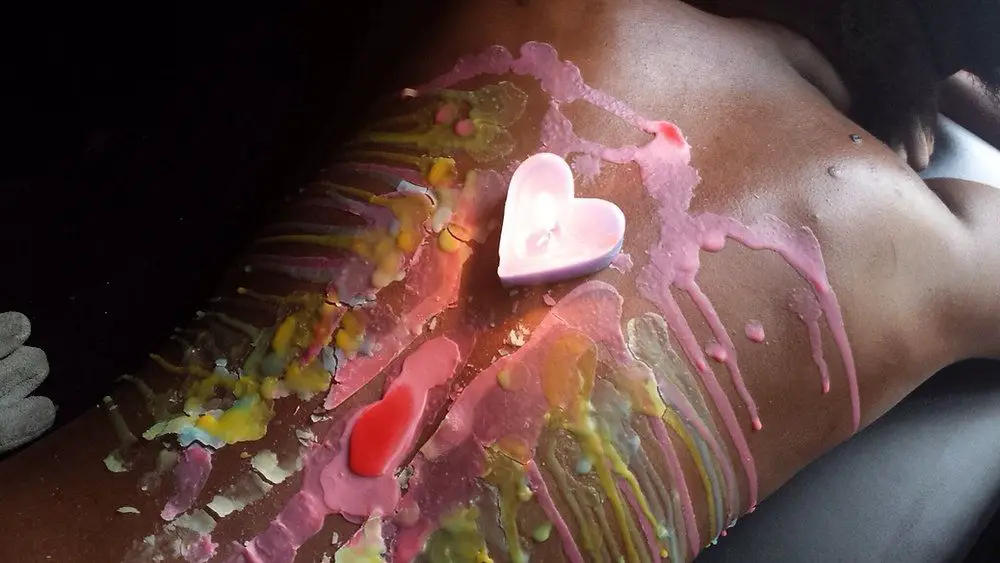What Is Candle Wax Poured On The Body?
What is candle wax play?
Candle wax play is a BDSM practice that involves pouring hot candle wax directly onto a partner’s body for erotic pleasure and intense sensations. It is considered an ‘edgeplay’ activity due to the potential risks involved. The melted wax is dripped from a candle onto areas like the back, chest, arms, legs and genitals. As the wax cools and hardens on the skin, it creates unique sensations and patterns.
Wax play allows partners to safely explore pain and pleasure. The hot wax provides a prickling, stinging sensation as it hits the skin that many find arousing. Though initially intense, the pain tends to dissipate quickly. The layer of wax left behind then acts as a protective barrier against the heat of drops that follow. This alternating feeling of heat and cooling can create waves of excitement and adrenaline. The unpredictability of where the wax will land next also contributes to the thrill and anticipation. Partners may alternate between roles, dripping wax on each other. Safety and communication are paramount throughout a wax play session. When performed correctly by knowledgeable partners, it can allow for intimate, creative and sensual expression.
History and Origins
The origins of candle wax play can be traced back to ritual practices in ancient cultures. Historians have found evidence that early civilizations such as the Chinese, Egyptians, and Romans used wicked candles made from available plants and insects for ritualistic purposes (https://candles.org/history/). While not explicitly for erotic purposes, dripping hot wax on the body was seen as a spiritual and transformative experience.
In the modern BDSM era, wax play emerged as a form of sensual temperature play. Practitioners drew inspiration from the ritualistic use of wax in ancient cultures and tailored it into an erotic practice. The first documented accounts of erotic wax play in a BDSM context began in the 1970s and 1980s. Early wax play often used homemade candles or basic paraffin wax candles dripped from a height onto a bound partner.
Over time, wax play has evolved to use specially designed low-temperature candles made from soy, beeswax and other natural waxes. Safety precautions around flame play have also developed as the practice became more widespread. While still considered an edge play, wax play is now a common and popular activity in BDSM scenes when performed safely between consenting partners.
How It Works
Wax play involves pouring or dripping melted wax from a candle onto a partner’s skin for erotic pleasure and sensations. Special candles made from soy, beeswax, or paraffin wax are commonly used. These candles have a lower melting temperature than standard candles, usually between 125-135°F. This allows the wax to be warm without burning or blistering the skin.
To begin, the top layer of wax is melted by lighting the candle. Once liquid, the wax can be poured directly onto the skin or dripped from a height to allow it to cool slightly midair. Dropping from higher distances increases anticipation and intensity. The most common areas wax is applied to are the back, chest, arms, legs, feet, and butt. Care should be taken to avoid sensitive areas.

When the wax hits the skin, it causes a warm, prickling sensation. Many find this mix of heat and anticipation pleasurable. As the wax cools and hardens it can feel restrictive or weighted, heightening sensitivity. The wax is peeled off after hardening, which some find provides a tickling or relieving sensation.
Proper wax play requires using the right candles and taking safety precautions. But when done correctly, many find wax play to be an intense yet safely indulgent form of foreplay.
Sensations and Psychology
Wax play creates unique physical sensations that many find pleasurable. The hot wax initially feels warm as it hits the skin. As it cools and hardens, there is a tingling feeling and contrast from the hot wax and cooled wax 1. The anticipation of where the wax will land also adds psychological excitement.
For some, the slight stinging creates an endorphin rush similar to other forms of sensation play. The mix of pleasure and pain can heighten arousal. Wax play allows individuals to safely push their boundaries and release inhibitions in a controlled manner 2.
The molten wax can create a visceral, sensual experience when dripped on erogenous zones. The warmth and texture provides unique sensations compared to other types of touch. Individuals who enjoy wax play often report increased connection and intimacy with their partner 3.
Wax play appeals to those who want to experience varying sensations and explore new forms of erotic play. It allows individuals to be both in control of giving the wax and surrendering to the unpredictable sensations. With proper precautions, wax play provides a way to safely indulge exotic fantasies.
Safety Tips
When engaging in wax play, it’s important to keep safety top of mind. Proper wax temperatures and avoiding burns are key. According to SHA’s Guide to Wax Play, wax should be tested on the inner wrist first before pouring on the body. The ideal temperature range is 43°C to 53°C (110°F to 127°F). Any hotter can risk burns. Take care not to pour wax from too high above, as falling from a height can make it dangerously hot on impact.
It’s also crucial to observe fire safety with an open flame in the scene. Keep wax play a safe distance from anything flammable, like bedding. Have a damp towel on hand to quickly extinguish a flame if needed, according to Well+Good. Discuss and establish emergency procedures beforehand. Establish a non-verbal safe signal if one partner needs to pause or stop the scene.
Proper aftercare is also an essential part of wax play safety. Gently remove any dried wax residue. Apply a soothing aloe-based moisturizer to any skin that was exposed to wax. Be alert to any blistering or burns that require medical treatment. Keep communication open with your partner about the experience and aftercare needs.
Techniques and Varieties
There are several techniques for engaging in candle wax play:
Dripping: Slowly dripping hot wax from a distance onto the skin. This allows the wax to cool a bit before hitting the body. DRipping concentrated amounts on specific body parts is a popular technique. Go slowly and start from higher distances when first starting out.
Spreading: Pouring wax onto the body and then spreading it around using tools, hands, etc. The wax can be spread onto large areas like the back or chest. Feathers may be used to spread the wax in sensual patterns. Spreading allows more skin surface area to be covered.
Body parts: Common areas to drip or spread wax onto include the chest, stomach, inner thighs, back, arms, feet. Sensitive areas like the nipples may provide extra sensation. Avoid vulnerable areas like the face and neck, especially for beginners.
Combining practices: Wax play is commonly combined with other BDSM activities like bondage and spanking. The wax sensations can enhance the experience. Blindfolding enhances the suspense and surprise of where wax will land next.
There are many creative ways to use wax during intimate play. Always start slowly and communicate preferences with your partner. Stop immediately if pain levels become uncomfortable. With some care and creativity, wax play allows couples to reach new heights of arousal and connection.
Benefits and Drawbacks
Candle wax play can provide a number of potential benefits when practiced safely between consenting partners. The sensations of warm wax being dripped onto the skin can induce feelings of relaxation and stress relief for some. The anticipation of not knowing where the next drop will land can also increase arousal and lead to enhanced intimacy between partners.
However, there are also some drawbacks and risks to be aware of. The wax itself can sometimes be painfully hot, especially if not tested properly first. Burns are a possibility if the wax is too hot. There is also a risk of wax getting into eyes or other sensitive areas, which should be avoided. Proper safety precautions need to be taken.
Additionally, wax play may not be enjoyable for everyone. Some may find the sensations to be more annoying or uncomfortable than pleasurable. It’s important to communicate openly with your partner about your comfort levels. Start slowly and do not feel obligated to continue if it is not satisfying for you. With the right precautions, communication, and mindfulness, wax play can be an adventurous expansion of intimacy for couples. But it also has drawbacks to consider before engaging.
Popular Culture Depictions
Candle wax play has been depicted in various forms of popular culture, including movies, TV shows, books, and music. Some notable examples include:
In film, candle wax play scenes appear in movies like Fifty Shades of Grey, Secretary, and Exit to Eden. These depict wax being dripped on bare skin during intimate encounters. While sometimes portrayed as painful, the scenes also show the sensory experience and eroticism of wax play.
On television, wax play has been featured in shows like American Horror Story: Coven, Nip/Tuck, CSI: Miami, House, and Orange Is the New Black. Though not always in a sexual context, these shows demonstrate wax being dripped on both willing and unwilling participants.
In books, erotic novel series like Fifty Shades prominently feature wax play during steamy scenes. The wax is described as inducing a burning sensation, contrasted by the cold of ice cubes. The novel Exit to Eden also contains wax play between characters.
Within music, songs like “Flesh” by Simon Curtis reference dripping hot candle wax during intimate acts. Wax play is portrayed as a provocative and tantalizing sexual experience in the lyrics.
Some performance artists also incorporate wax play into their work, dripping wax on themselves or others during live shows or photography sessions. Lady Gaga is one example of a performance artist who has integrated wax play into her artistic expression.
Psychological Aspects
Wax play can provide a profound psychological experience for participants. The sensations of hot wax on the skin can induce a trance-like mental state. The anticipatory arousal as one awaits the dripping wax can be intensely erotic. Wax play involves a transfer of power and control, as the person applying the wax takes the dominant role. For the recipient, surrendering to the wax induces a release of inhibitions and deep relaxation. There is an element of risk and danger, which engages our primal desires. The heightened sensations require focus and presence, bringing a meditative quality. Wax play is an immersive experience that can induce altered states of consciousness related to submission, masochism, and sensual domination.
According to Wikipedia, “Wax play induces a trance-like state which can facilitate an altered state of consciousness.” The psychology of wax play relates to the mind-body connection and tapping into our erotic imaginations.
Wax play provides a visual, tactile, and psychological experience that engages the senses and psyche. The warm wax on the skin induces vulnerability and openness. Trust and communication are essential for safe practice. Negotiating boundaries and comfort levels allows partners to relax into the experience.
For some, wax play is a form of ritual and spiritual eroticism. The practice cultivates presence and connection. It provides psychological intensity that can enhance intimacy between partners. With proper safety precautions, wax play offers psychological depth in addition to sensual pleasure.
Getting Started with Candle Wax Play
If you’re new to wax play, there are some important tips to keep in mind before diving in. According to Well+Good, it’s smart to start with plain paraffin candles, which have a lower melting point and are safer for beginners. Purchase high-quality candles made specifically for body application, like those from reputable sex toy shops. Stay away from scented or colored candles, which can irritate skin.
For your first time, Cosmopolitan recommends having your partner take the dominant wax-pouring role. This allows you to fully focus on the new sensations and vocalize your comfort level. Always establish boundaries beforehand and have a safe word in place. Never pour wax near eyes, lips, or other sensitive areas. Start by dripping wax from farther away before moving the candle closer to the body. Pay attention to temperature – warm wax provides a gentle tingle, while hotter wax intensifies sensation.
Discuss wax play with your partner to gauge their interest and identify any hard limits. Go slowly, communicate frequently, and stop immediately if pain exceeds pleasure. This builds trust in the relationship and a foundation for more advanced wax play in the future.



